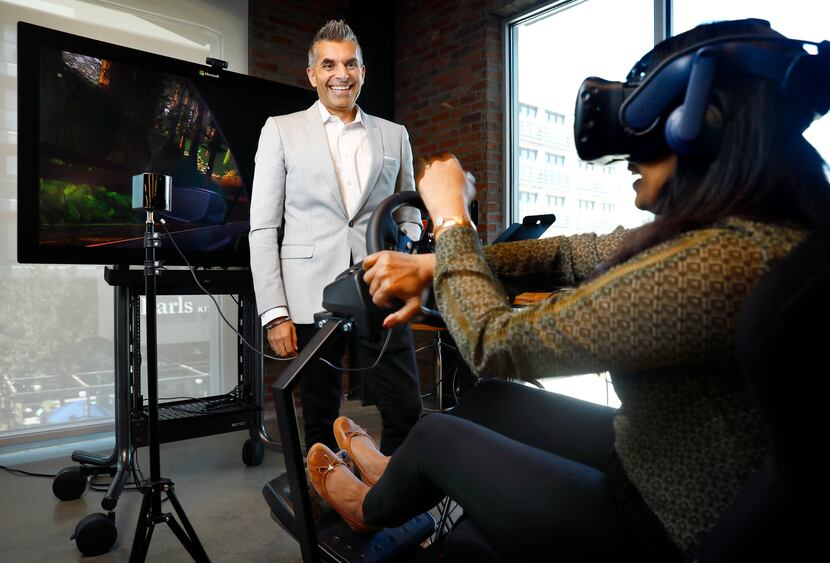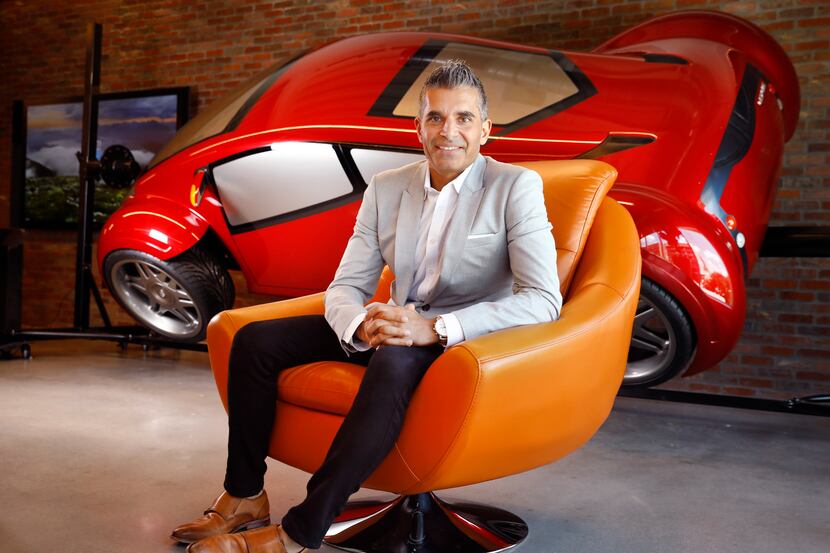The Plano office of Toyota’s mobility and innovation arm looks like a sleeker version of the typical bright white, open-floor startup.
On one wall of the Legacy West space, employees tape up a photo of themselves from childhood.
“Because at that time in life, we believe anything is possible,” said Steve Basra, the new CEO of Toyota Connected.
The company started six years ago with five people, including Basra.
“We just stole some desks at the main headquarters office,” Basra said about the company’s early days.
Now the Plano office has undergone several expansions to accommodate the growing team of technologists responsible for the bells and whistles that go into all Toyota cars, from a Corolla to a Lexus LC. It has grown to 240 employees, with additional offices in India and London.
Examples of their work include an emergency assistance button that connects you with 24/7 roadside assistance and an automatic collision notification that alerts a 24/7 response center when an airbag deploys or when the rear of the vehicle has suffered a “severe” hit.
Basra stepped up as CEO in July to replace Zack Hicks, who retired after being with Toyota since 1996. Hicks is now the chief digital and technology officer at Irving-based Kimberly-Clark Corp.
Basra, 47, is a Toyota loyalist, having been with the company his entire 24-year career, which started in the automaker’s IT department. He lived in Kentucky, Belgium and Japan before moving to Texas in 2016 to become Toyota Connected’s chief technology officer.
Having a separate company to focus on connected vehicles, information systems and research and development gives the team more freedom, Basra said. Within a big company, it’s hard to spur innovation sometimes, he said.
“We can’t serve beer at the main headquarters, but we can do it here,” he said, referring to the massive campus Toyota Motor North America built to house nearly 4,000 workers a short distance away. “You can’t provide free food to everyone at the main office, but you can here. So we’re close enough because it’s just down the road, but we’re far enough away that we can have that flexibility to do what we want.”
Basra recently sat down with The Dallas Morning News at Toyota Connected’s newly renovated headquarters to talk about his vision for its future. His answers have been edited for brevity and clarity.
What new projects are in the works for Toyota vehicles?
Something that we call service connect, where we use data from the vehicle to try to predict when something is going to happen to your vehicle — whether it’s that you need to change your oil or have an engine issue. We want to be able to predict that before you get an alert. We can send customers a message through our app, connect them to a dealership and show them available appointment times.
One other idea we’re looking to launch soon is, say you’re on a walk and you’ve parked your car on the street and it’s dark at night and you don’t feel safe. What we want to do is have a safety service so you can touch a button on your phone and get through to a real-life person who will stay on the phone with you until you’re in your car. And while you’re walking to your car, we can switch on all your vehicle lights and if, God forbid, something does happen, we can contact the emergency services straight away and they know where you are.
How competitive is it among automakers for technologists?
It’s huge. All original equipment manufacturers are transitioning to where they’re trying to build a company similar to this one, or they’re trying to be in technology. It’s massively competitive. But it’s not just OEMs. For every company now, this is going to be an ongoing battle.
But I think we’re well-placed. We have four months of paternity leave, for example, and we expect you to take them. And we spent a lot of time on the organization structure to make sure we have the right people, and that they’re getting their time with managers and mentors to build their careers. We are fully hybrid. There is no pressure to come into the office. It’s worked very smoothly for us. We want to treat our employees like adults.
And I don’t care if people leave. What I mean by that is, it’s natural that people will move around in the technology sector, and we don’t look unfavorably on people when they do that. We don’t try to put in policies that don’t help people grow. Our goal is to build policies where we treat people how they want to be treated and hope they stay, rather than trying to force people to stay.
The phone industry has matured, with only slight improvements each year. What do you think about the auto industry?
We’re just at the start of our transformation. I think you’re 100% right. If you look at the iPhone 14, it is a bit of a joke. If you look at what’s changed, there’s really nothing. What makes it so exciting in this space is that we don’t know what the future is. We get to decide what the future will be. It’s very rare that you get to work in an industry in technology where you can make that statement. I’ve mentioned to all our employees that they’re the ones who are going to decide what the consumer experience in all vehicles will be in the future.
Think about it. Connected vehicles, they’ve really only been around for the last five to 10 years. And it’s only in the last two to three years that people have really started to take it seriously and started to think about what this could mean.

Does what your team creates increase the price of a Toyota?
I try not to say that. I try to say that we add cost to a car and we take cost out. We can do both. We try to remain cost-neutral. Yes, we’re putting bigger screens into the car and stuff like that. But by putting bigger screens in, you’re also taking costs out because now you need fewer buttons and less physical hardware in the vehicles. It’s a trade-off.
Technology is where the future is. When I got my first car, it was about the engine. Nowadays, most people don’t look at the engine. The first thing they look at is technology. They get in the car. They look at the screen. They look at what it can do. So, yes, we may be adding cost, but I think that is where the cost should go because that is what consumers want.
Is there ever a time when you think, ‘We could make the car do this, but then it would be too expensive?’
Yes, all the time. That has huge trade-offs. You look at some OEMs putting so many screens everywhere, but I think they’re missing the point. Do consumers want more screens in their car? Or do they just want a phenomenal experience? I think they want a phenomenal experience. The danger is that we just keep on putting more technology into these vehicles. I think that’s the wrong idea.
So when someone comes up with an idea, let’s try it. Let’s not dismiss it. Let’s figure it out. If it’s really, really expensive, let’s see if we can figure out a better way of doing it using technology and what compromises we have to make. That is our job every day. It really is.
What car do you drive?
I try to drive every car we have. I had the Lexus LC just recently. I just gave that back. Now I’m driving a [Lexus] GX, which is the complete opposite. With our group, we have every car because we’re building the technology for the in-car systems. I can just go in and pick the car I want to drive for that week or that month. I encourage my team to do the same. It’s really important that we know our product.

